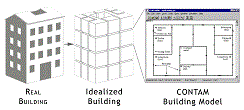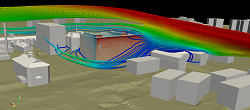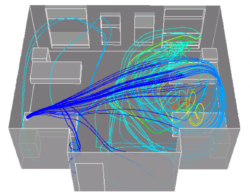Real-Time Airflow Simulation
Airflow Simulations
The movement of air in a room can be predicted using mathematical and computational algorithms much like the weather forecasting using a process called computational fluid dynamics. The problem that is currently faced by industry and practitioners is the turnaround time required to calculate even the simplest airflow patterns; this can rage from hours to days or even weeks. Our aim is to forecast the indoor air movements so we can help infection control teams make informed decisions about both patient comfort and infection control.

Fast
Being able to predict IAQ parameters needs a high-speed computational code, capable of high quality visual outputs.

Parallel
Scalability comes with parallelisation. Our codes will be applicable to real-world problems including dynamic environments.

Integrated
A IAQ prediction code needs to interface easily with its changing boundary conditions including assimilating sensor data and infection risk models.
Real-Time Simulation - The Lattice-Boltzmann Method for GPU
We have developed an in-house code based on the Lattice-Boltzmann method that runs on the computer's graphics card (GPU), much like video game consoles. The difference is that this is built for accuracy while balancing the requirements for speed. We can predict the movement of the air and with it airborne laden germs faster than we can see them move. A toy example of a doctor in a hospital room can be seen in the following video.
We will be using the sensor data from measured air quality parameters to help guide the simulations so that when the prediction begins to deviate too much from reality, this can be corrected with real data. Read more about wireless sensor networks here.
Our most recent publication can be downloaded from the White Rose repository here.
Interfacing Modules
The LBM code will interface with dynamic thermal models, external weather files and particle deposition models.

Multi-Zone Modelling
We will use dynamic thermal models to simulate years worth of indoor thermal conditions based on local weather files. This will then be compared against the LBM simulations to check accuracy.

External CFD
Coarse-mesh computational fluid dynamics models will be built of the hospital buildings to check for the effect of sheltering of neighbouring buildings. This can be used to investigate façade pressure coefficients that can impact natural ventilation or positively pressurised isolation rooms during storms.
 Modelling Bioaerosols Transport & Deposition
Modelling Bioaerosols Transport & Deposition
Pathogens are known to be transported around the room on air currents but what we don't know is where they go. We will use computational fluid dynamics to make a model of patient rooms to investigate the spread and deposition of airborne microorganisms on surfaces. This will be compared with experiments looking at the effect of deposition and pathogen viability over time at our biological facilities at the University of Leeds. Read our previous publications for free here and here.
